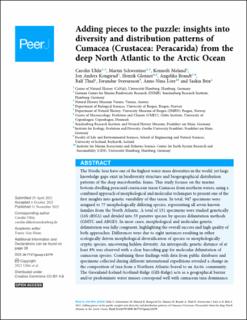| dc.contributor.author | Uhlir, Carolin | |
| dc.contributor.author | Schwentner, Martin | |
| dc.contributor.author | Meland, Kenneth | |
| dc.contributor.author | Kongsrud, Jon Anders | |
| dc.contributor.author | Glenner, Henrik | |
| dc.contributor.author | Brandt, Angelika | |
| dc.contributor.author | Thiel, Ralf | |
| dc.contributor.author | Svavarsson, Jörundur | |
| dc.contributor.author | Lörz, Anne-Nina | |
| dc.contributor.author | Brix, Saskia | |
| dc.date.accessioned | 2022-03-18T09:47:42Z | |
| dc.date.available | 2022-03-18T09:47:42Z | |
| dc.date.created | 2021-12-03T10:17:24Z | |
| dc.date.issued | 2021 | |
| dc.identifier.issn | 2167-8359 | |
| dc.identifier.uri | https://hdl.handle.net/11250/2986121 | |
| dc.description.abstract | The Nordic Seas have one of the highest water-mass diversities in the world, yet large knowledge gaps exist in biodiversity structure and biogeographical distribution patterns of the deep macrobenthic fauna. This study focuses on the marine bottom-dwelling peracarid crustacean taxon Cumacea from northern waters, using a combined approach of morphological and molecular techniques to present one of the first insights into genetic variability of this taxon. In total, 947 specimens were assigned to 77 morphologically differing species, representing all seven known families from the North Atlantic. A total of 131 specimens were studied genetically (16S rRNA) and divided into 53 putative species by species delimitation methods (GMYC and ABGD). In most cases, morphological and molecular-genetic delimitation was fully congruent, highlighting the overall success and high quality of both approaches. Differences were due to eight instances resulting in either ecologically driven morphological diversification of species or morphologically cryptic species, uncovering hidden diversity. An interspecific genetic distance of at least 8% was observed with a clear barcoding gap for molecular delimitation of cumacean species. Combining these findings with data from public databases and specimens collected during different international expeditions revealed a change in the composition of taxa from a Northern Atlantic-boreal to an Arctic community. The Greenland-Iceland-Scotland-Ridge (GIS-Ridge) acts as a geographical barrier and/or predominate water masses correspond well with cumacean taxa dominance. A closer investigation on species level revealed occurrences across multiple ecoregions or patchy distributions within defined ecoregions. | en_US |
| dc.language.iso | eng | en_US |
| dc.publisher | PeerJ | en_US |
| dc.rights | Navngivelse 4.0 Internasjonal | * |
| dc.rights.uri | http://creativecommons.org/licenses/by/4.0/deed.no | * |
| dc.title | Adding pieces to the puzzle: insights into diversity and distribution patterns of Cumacea (Crustacea: Peracarida) from the deep North Atlantic to the Arctic Ocean | en_US |
| dc.type | Journal article | en_US |
| dc.type | Peer reviewed | en_US |
| dc.description.version | publishedVersion | en_US |
| dc.rights.holder | Copyright 2021 Uhlir et al. | en_US |
| dc.source.articlenumber | e12379 | en_US |
| cristin.ispublished | true | |
| cristin.fulltext | original | |
| cristin.qualitycode | 1 | |
| dc.identifier.doi | 10.7717/peerj.12379 | |
| dc.identifier.cristin | 1964044 | |
| dc.source.journal | PeerJ | en_US |
| dc.identifier.citation | PeerJ. 2021, 9, e12379. | en_US |
| dc.source.volume | 9 | en_US |

